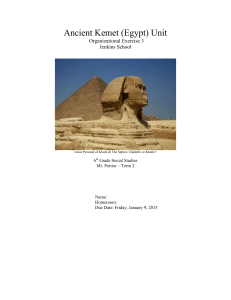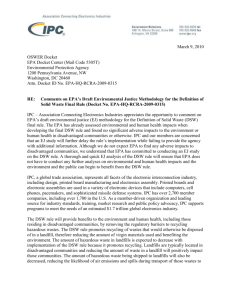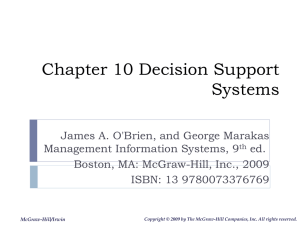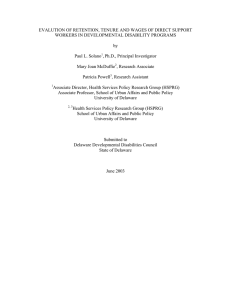ANALYTICAL SUPPORT FOR SOCIAL WELFARE POLICY AND
advertisement
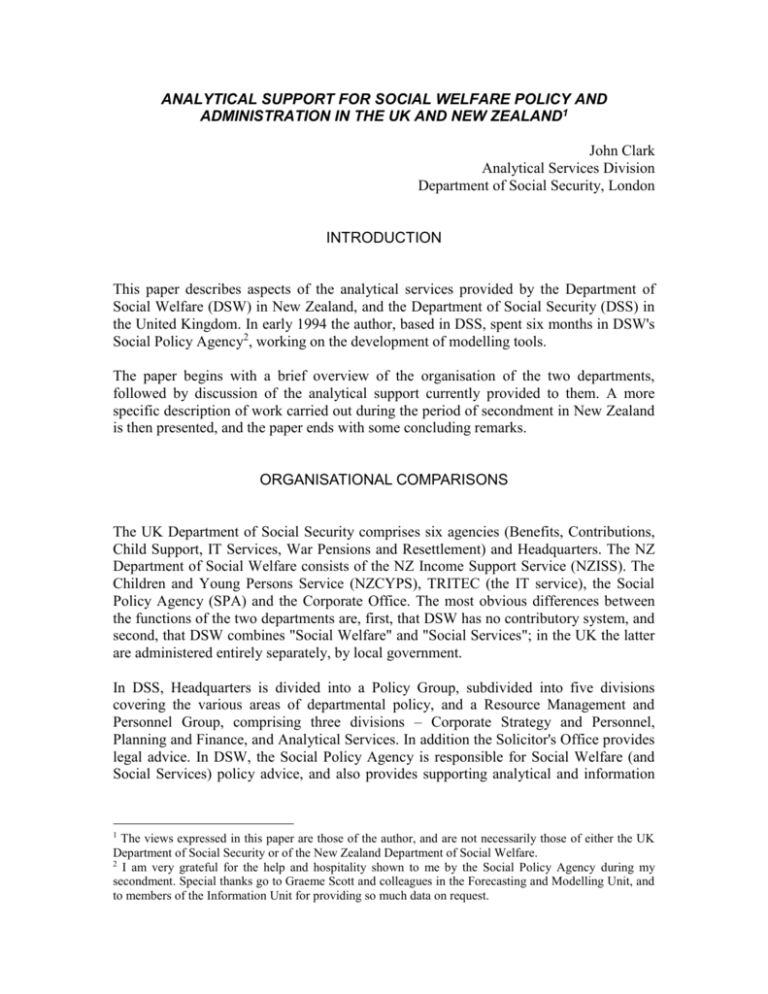
ANALYTICAL SUPPORT FOR SOCIAL WELFARE POLICY AND ADMINISTRATION IN THE UK AND NEW ZEALAND1 John Clark Analytical Services Division Department of Social Security, London INTRODUCTION This paper describes aspects of the analytical services provided by the Department of Social Welfare (DSW) in New Zealand, and the Department of Social Security (DSS) in the United Kingdom. In early 1994 the author, based in DSS, spent six months in DSW's Social Policy Agency2, working on the development of modelling tools. The paper begins with a brief overview of the organisation of the two departments, followed by discussion of the analytical support currently provided to them. A more specific description of work carried out during the period of secondment in New Zealand is then presented, and the paper ends with some concluding remarks. ORGANISATIONAL COMPARISONS The UK Department of Social Security comprises six agencies (Benefits, Contributions, Child Support, IT Services, War Pensions and Resettlement) and Headquarters. The NZ Department of Social Welfare consists of the NZ Income Support Service (NZISS). The Children and Young Persons Service (NZCYPS), TRITEC (the IT service), the Social Policy Agency (SPA) and the Corporate Office. The most obvious differences between the functions of the two departments are, first, that DSW has no contributory system, and second, that DSW combines "Social Welfare" and "Social Services"; in the UK the latter are administered entirely separately, by local government. In DSS, Headquarters is divided into a Policy Group, subdivided into five divisions covering the various areas of departmental policy, and a Resource Management and Personnel Group, comprising three divisions – Corporate Strategy and Personnel, Planning and Finance, and Analytical Services. In addition the Solicitor's Office provides legal advice. In DSW, the Social Policy Agency is responsible for Social Welfare (and Social Services) policy advice, and also provides supporting analytical and information 1 The views expressed in this paper are those of the author, and are not necessarily those of either the UK Department of Social Security or of the New Zealand Department of Social Welfare. 2 I am very grateful for the help and hospitality shown to me by the Social Policy Agency during my secondment. Special thanks go to Graeme Scott and colleagues in the Forecasting and Modelling Unit, and to members of the Information Unit for providing so much data on request. services. The counterparts of the other functions of DSS Headquarters are provided, in DSW, by Corporate Office. The respective providers of analytical support are thus the Analytical Services Division (ASD) in DSS, and part of the Social Policy Agency (SPA) in DSW – specifically, the Social Policy Information Service within SPA. The activities undertaken, and the kinds of support provided by these bodies, are considered below. WHAT ANALYTICAL ADVICE IS NEEDED BY WELFARE DEPARTMENTS? Policy Any change in policy, from a major restructuring of the tax benefit system to a minor change in the eligibility rules or rates of payment for a particular benefit, will have shortand long-term effects which may be difficult to assess without analysis. Before the policy is enacted, the objective will presumably be clear and the target client group identified. However, because of the complexities involved in the system, quantification of the costs of (or savings from) the change, the numbers and characteristics of the "winners" and "losers", and of those newly-qualifying or ceasing to qualify for benefit, is typically uncertain. As by definition there is no experience of application of the policy, simulation of some sort is likely to be required to address these issues. This may also be used to assess long-term dynamic issues thought likely to pose problems in the future, such as funding arrangements for pensions. Use of simulation in DSS and DSW is discussed in the sections below. There is obvious interest in evaluating and monitoring the effects of a policy after it has been put into practice. This monitoring may be relatively straightforward, requiring the collection and dissemination of routinely collected data; however additional research may be necessary or desirable, for example to obtain detailed information on the impact on particular client groups through a specially designed questionnaire. The production of expenditure forecasts is another activity regarded as central by both groups; these forecasts are required by Finance Divisions as inputs to Public Expenditure estimates and Budget arithmetic. Administration and Operations Resources used to administer Social Welfare provision are considerable because of the size of their operations. The areas where analytic advice can make a contribution include: forecasts of workloads of various kinds, which can be translated into requirements for staff and other resources; advice on resource allocation, to ensure that resources are in the right place to do the job most effectively; help with the appropriate targeting of effort, for example, by identifying areas where incorrect benefit payments are most likely, and hence where scrutiny should be closest; development of performance indicators, which if well-conceived should encourage activities most directly in line with the Department's aims and objectives. PROVISION OF ANALYTIC SUPPORT IN DSS AND DSW Both ASD (DSS) and SPA (DSW) provide advice over the range outlined above, but there are significant differences in the approaches used. For policy analysis, the technique of microsimulation can be a useful tool. This technique involves the use of a database comprising micro-level data, i.e. where each record comprises the circumstances of an individual, family or household. The data are usually derived from random sample surveys covering several thousand households, such as the Family Expenditure Survey in the UK, or the Household Expenditure and Income Survey in New Zealand. By applying benefit rules (actual or proposed) to each record in turn, the eligibility and entitlement of each family in the sample can be assessed. A "grossing up" procedure is then applied, whereby results from the sample in the database are converted into estimates for the population as a whole. The factors used in the conversion process depend on the size of the sample relative to the total population, and the extent to which the sample is representative of particular population characteristics. By using this process, the overall costs of a proposed change can be estimated, as can its effects on groups in the community with particular personal circumstances. This method has been used extensively by the DSS in the UK for several years. The Policy Simulation Model (PSM) incorporates data from three successive Family Expenditure Surveys to simulate the effects of tax and/or benefit policy options. The model is static (i.e. the families in the database do not "age", and only immediate "firstround" effects of a policy change are examined). The model does not include "behavioural" effects (i.e. there is no representation of the way people's behaviour might change, for example in response to changes deigned to provide work incentives). A second model ("PENSIM"), currently under development, addresses the question of lifetime earnings, the distribution of incomes of pensioners and their likely reliance on income-related benefits. In contrast to the PSM it is dynamic, with some individuals changing their employment status (and associated pension rights) in a given period according to estimated transition probabilities. Microsimulation has also been used in DSS for forecasting. Forecasts of expenditure on particular benefits are made by first assuming that the population of beneficiaries remains as at present, and applying uprating factors related to assumed movements in price and wage indices. These may cause some groups with particular characteristics to "float on" to benefit (become eligible), and/or others to "float off" (cease to be eligible). Other (nonprice) change factors are accounted for by off-model adjustments, as estimated by separate analysis. In New Zealand, two microsimulation models (TAXMOD and ASSET) are in use in Government departments, but neither is "owned" by the Department of Social Welfare. These models require substantial resources to develop and maintain, and it is difficult for the Social Policy Agency to justify the development of a similar model of its own in the light of competing priorities. A fully-fledged microsimulation model requires similar input whether it represents a country of 3.5 million people (like New Zealand) or one fifteen times as large (like the UK), with correspondingly greater resources. The options open to New Zealand and an outline of the modelling work carried out during my secondment are described in the next section. Forecasts of benefit expenditure in New Zealand are made benefit-by-benefit using a variety of techniques, mostly informal. A number of significant changes in social behaviour over the last few years, combined with a large number of important policy changes affecting most (if not all) benefits, suggests that knowledge of the system and sound judgement, together with competent basic analysis, are more valuable attributes for producing good forecasts than great technical sophistication. Both DSS and DSW carry out extensive evaluation work to assess the practical impact of policies. The DSS has a relatively large social research capacity – the branch in ASD responsible for this work has a staff of some 20 professionals and 5 support staff, and a budget of £4m in 1994-95 for funding externally-contracted research. As far as policy evaluation is concerned, currently active areas include Job Seeker's Allowance (replacing Unemployment Benefit), Disability Benefits and Pensions. Corresponding activities in the Social Policy Agency of DSW are carried out in the Research and Evaluation Units of the Social Policy Information Service. Of these two units, which together are staffed by some 13 people, Research tends to carry out longerterm strategic studies (mostly in-house), but there is considerable overlap with Evaluation. A major topic of current interest is an evaluation of Accommodation Supplement, following recent changes in the system of housing benefits in New Zealand. Technical support for administrative/operational activities is more centralised in the UK, with a branch of ASD devoted to Operational Research and covering resource management, pay and manpower issues, information systems, workload forecasting, performance indicators and other statistical advice on operational issues. The Executive Agencies, rather than HQ, are the customers for much of this work. Within DSW, SPA carries out workload forecasts for NZISS, but most analysis relating to operational work is carried out elsewhere in the Department. MICROSIMULATION IN NEW ZEALAND When I arrived in New Zealand for the period of secondment, there was considerable interest within the Social Policy Agency in developing a microsimulation capability. In view of resource constraints, three alternative ways forward were considered: a) to collaborate with other departments in constructing a new model; b) to make use of TAXMOD, maintained by the Treasury, adapted for DSW use as appropriate; c) to develop an alternative approach. With regard to (a), several other departments, such as Education and Health, expressed interest in microsimulation work. However, they also found it difficult to commit resources and were understandably primarily interested in issues central to their own concerns. The option to adapt TAXMOD, to which DSW has access, has the advantage of utilising a tax/benefit model in which a great deal of development work has already taken place. A disadvantage is that use of this model implies a lack of independence from the Treasury, and there were also concerns about some aspects of the model's performance. Nevertheless, it was considered worthwhile to pursue this option further, as well as exploring alternative approaches to policy analysis. As a first step, I undertook to review TAXMOD to assess its suitability for use by DSW, and if appropriate, to recommend modifications to it (Clark 1994a). With the cooperation of Treasury analysts I familiarised myself with the operation of the model, and as far as possible compared the outputs of the model with historical data to check validity. While the model performed quite satisfactorily in many respects, the review confirmed earlier concerns about the adequacy of the database. Each model run is based on one year's Household Expenditure and Income Survey (HEIS) data, comprising details of the circumstances of around 4000 households, chosen as a geographically-based stratified random sample. It is clear that the sample is likely to contain very small numbers of people in particular circumstances, e.g. members of a specified family type on a particular benefit, and hence that some kinds of detailed analyses are subject to considerable error. The problem is compounded by the fact that beneficiaries in general are severely under-represented in the HEIS databases. Also, it turned out that the non-benefit income recorded on HEIS for welfare beneficiaries is, on average, much higher than that recorded on Social Welfare's own departmental database (SWIFTT). One reason for this is that HEIS records all income obtained in a year, including any periods when the person was not receiving a benefit, whereas SWIFTT records only income obtained while receiving a benefit and no prebenefit income. Non-benefit income is important in determining benefit entitlement in New Zealand, as benefit is "abated" at fixed percentage rates as non-benefit income rises to certain levels. SWIFTT contains details from benefit claims, on the basis of which, eligibility for benefit is assessed. Irrespective of which database is the more "accurate", therefore, it is the SWIFTT information that translates into actual benefit expenditure, and to the extent that TAXMOD data is inconsistent with it, the model will produce misleading expenditure estimates. The main conclusion from the model review was that data for benefit recipients input to the model should be taken from SWIFTT rather than HEIS. For the new aggregate database, SWIFTT beneficiary data would be combined with HEIS records for nonrecipients. The Information Unit of SPA co-operated in providing an extract from SWIFTT containing some 8000 records in a format suitable for input to TAXMOD, giving a combined database of about 11,500 records. AN ALTERNATIVE MODEL It is sometimes observed that the development of large-scale computer models can develop a momentum of its own. Ad hoc requests for additional programming work, however well-conceived at the time, lead to increases in model complexity; as, typically, model documentation leaves something to be desired. As programmers and analysts come and go, it is not unusual for a model to develop into an elephant whose operation is understood by nobody – it becomes a "black box". Partly driven by necessity, but also from a belief in the virtues of simple models and as a antidote to the "black box" syndrome, it was decided to experiment with building a very simple microsimulation model within DSW.3 This could not have the range of applicability of TAXMOD or similar models, but could hopefully address some central issues in a transparent and flexible way. In the model as it currently exists, the database comprises some fields from the 11,500 or so records from the HEIS and SWIFTT databases referred to above. The data input to the model is the "core" minimum considered necessary for the estimation of benefit due. It consists of the following fields: type of benefit received (if any) family type (e.g. couple, sole parent) number of dependent children "other" (i.e. market) income of family age of recipient district of residence 3 More details, including a programme listing, are contained in J. Clark, "A Simple Microsimulation Model" (1994b). Beneficiaries are categorised by a basic three digit code indicating family type, number of children, and market income range. Representing the code as ABC, the indicators are as follows: A = 1 (single person) or 2 (couple). Adult children, boarders etc. are treated as singleperson families. B lies between 0 (no dependent children) and 5 (five or more dependent children). C = 0 signifies no market income (or loss), and C = 1 market income in the range $0$40 per week. Incomes are then classified in $10 per week ranges (with increasing values of C) up to $100 per week, with C = 8 indicating more than $100 per week. These income ranges are chosen to capture groups falling within the various abatement bands. The operation of the model is straightforward. Essentially, the details are extracted from the SWIFTT and HEIS sources, and the three digit code is set up. Actual or potential benefit rules are then applied and the amount of benefit to which each beneficiary is entitled is calculated according to the code (together with precise declared income to calculate abatement and, if appropriate, age). A "grossing up" procedure is then applied with a view to converting the results from the sample to represent as closely as possible the outcomes for the population as a whole. Because it contains the essential characteristics which determine benefit eligibility, the model is suitable for simulating the effects of any changes in the rules on major client groups. For example, one might be interested in the effects of changes in the abatement bands, lone parents' total incomes or the costs of changing the differential in entitlement between families with one or two children. Tests show that the model handles this kind of question quite satisfactorily, and the three digit code provides a convenient customer classification system. The model is not, of course, designed to assess comprehensive changes in the overall tax/benefit system, for which a larger model is required. CONCLUDING REMARKS As a country with a relatively small population, New Zealand inevitably suffers diseconomies of scale in some areas of analytic work. If circumstances were different, and resources more plentiful, DSW would very likely benefit from greater investment in human and analytical capital – more training for staff and ore long-term development work. This is not, however, to advocate the development of large, complex, general purpose models which, if not impenetrable initially, are in great danger of quickly becoming so. To command confidence, models must be intelligible in operation and their results readily explicable. The availability of a set of such tools is indispensable to an analytic unit and I hope that the development work I undertook contributed to DSW's tool kit. To some extent ASD has experienced the "black box" problem, having developed and adapted large models over many years. Recognising that forecasting structures had become somewhat ossified, a comprehensive review of approaches to forecasting is currently being undertaken. It is likely that the emphasis will change from a focus on specific benefits to one on client groups and that a wider range of techniques will be employed in future. It will be of great interest to compare analytic methodologies in use in the two countries a few years from now. REFERENCES Clark, J. (1994a) "An evaluation of TAXMOD", mimeo, Department of Social Welfare. Clark, J. (1994b) "A Simple Microsimulation Model", mimeo, Department of Social Welfare.
